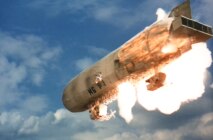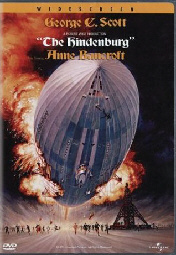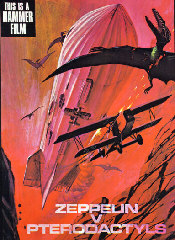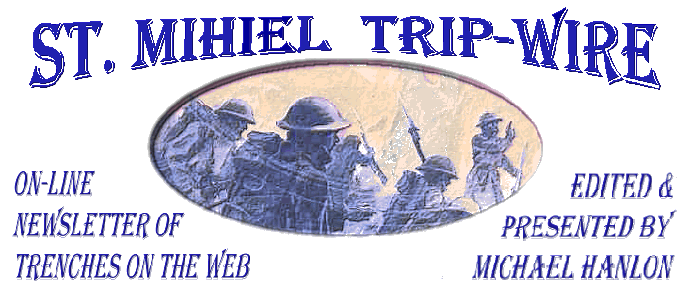
TRENCH REPORT: Howdy. This is the first Trip-Wire prepared on my new Windows Vista-equipped Dell computer. The past few weeks have been a computer adventure. I've had to replace many of my applications programs [an unanticipated increase of 50% in the project budget], and I still don't have the correct driver for my top-of-the-line HP Printer/ Scanner /Fax machine. Nevertheless, we are in production, so -- Onward! This month we are also trying an experiment. In the past I've turned down a number of longer articles because they did not fit into the Trip-Wire format and they would take too long for me to prepare. I've decided to try to apply some of the techniques I use for turning out our Over the Top monthly magazine--primarily by using Adobe Acrobat--for longer pieces. This month [see below] we are presenting a 3,100 word article written by regular contributor Len Shurtleff on a WWI relief organization. Please tell us what you think of this mode of presentation. MH
This Month's Internet Focus:
Gas Casualties
In WWI |

German Prisoners Captured by Canadians at the Somme
Note: The MP is Royal Canadian Mounted Police
July 1 is, of course, the anniversary of the battle's opening.
New at Our Own & Our Friends' Great War Websites
Click on Title to Access
|
At Great War Society Sites
The Great War Society Announces
Seminar 2008 War at Sea & in the Air
April 11-13 South San Francisco
(Click for Details) |
At the WFA-USA
|

Soldiers' Tips From Iraq That Might Be Rediscoveries of Lessons Their Grandfathers Learned in the Great War
A single wall of sandbags will not stop any significant munitions.
Supply each soldier with one tourniquet; we use a mini-ratchet strap that is one inch wide and long enough to wrap around the thigh of a soldier.
Cotton holds water. Even with the best socks, and plenty of foot powder, your feet are likely to start peeling like you've never experienced.
Do not let a casualty take your focus away from a combat engagement.
The second you see your soldiers start to lose interest, or roll their eyes, or not pay attention, your [intelligence officer] has failed, and you, your soldiers, and the mission are in danger.
I found these at the website of the New Yorker. They discovered these items on the websites of soldiers serving in Iraq. (Yes, we check out the New Yorker periodically. It was founded by a WWI veteran named Harold Ross.)
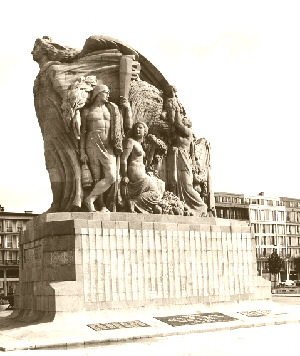 1914-1918 Memorial, Le Havre, France
(How did this avoid destruction in WWII?)

Woodrow Wilson concluded his April 2, 1917 War Message with these words: "God helping her, she can do no other."
The historian Mark Sullivan afterwards commented that this was directed to the German people, noting:
Probably not one in a hundred of his American hearers recognized that paraphrase of Martin Luther's declaration, immortal to every German Lutheran, "Ich kann nicht anders" (I can do no other).
|
Remember our Russian cartoon last month showing Nicholas and Alexandra sitting on Rasputin's lap? The text on the cartoon read: "Rossiyskiy tsarvstvovavshiy dom' " Trip-Wire readers Patsy Kennan and Kurt Schwarz sensed a challenge have provided some Slavic translation help: "An elegant solution is not really possible. The best we can do is:'The Russian House that reigned.' "
|
|
| |
French Machine Gunners (detail)
Lucien Jonas, 1915

|
GREAT WAR 2007 EVENT CALENDAR
|
90th Anniversary
Palestine Campaign
International Conference
September 3-6, 2007
Tel-Hai Academic College in Upper Galilee, Israel (email for details)
|
What We Fought
Each Other For
WFA-USA
18th National Seminar
September 7-9, 2007
Naval War College Newport, RI (Full Program)
|
T. E. Lawrence: A Symposium
The Huntington Library,
October 5-6, 2007
San Marino, CA (email for info.)
|
International Society for First World War Studies
International Conference
October 18-20, 2007
Georgetown University, Wash., D.C. (link)
|
Western Front Association
U.S. Branch Chapter Meetings
Check for Your Region
Regularly Updated (details)
|
Great War Society Monthly Chapter Meetings
Berkeley, San Francisco and Palo Alto, CA
Regularly Updated (details)
|
Send additions/corrections:
Email Response
|

Memorable Event
|

Third Ypres
Battle of Passchendaele Begins
July 31, 1917
Click on Image for More Information
|
|
Repairs to Liberty Memorial Observation Deck Complete
The orange barricades have been cleared away and guests are once again free to roam Liberty Memorial's Observation Deck for one of the best views of Kansas City.
If you are in London before July 7th, check out the play Forgotten Voices at the Assembly. It dramatises survivors' memories of the First World War and stars Matthew Kelly.
|
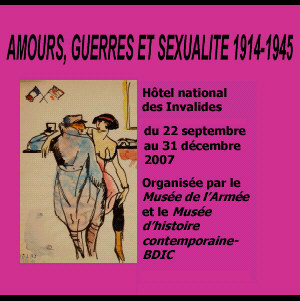
Trip-Wire Columnist Tony Langley Contributed To This Exhibit. He Will Be Reporting On It In a Future Issue
More on the TGV-East:
The TGV-East, the high speed train from Paris to Eastern France that runs at
over 300 kilometres per hour, made its first stop in the Meuse area on 10
June. The journey from Paris to the new Meuse station takes 55 minutes. From
there, a shuttle bus runs the 22 kilometres into Verdun city.
Unfortunately, the TGV timetable has not been arranged in such a way as to
allow for a one-day day visit to the Verdun battlefield. The only morning
arrival is on Saturday at 9.38am, with a return journey at 4.pm, which makes
for a very short day. So potential visitors with only one day to spare will
still have to make the return journey to Paris by the slow train.
The new station has car parking and is designed to accommodate travellers
with restricted mobility. Drinks and snacks machines are available. The
shuttle bus journey to Verdun from the Meuse station takes 25 minutes and
costs 4 euros. Tickets for the bus may be bought either on arrival or when booking the
TGV ticket. Christina Holstein.
|
|
Mystery Photo
|
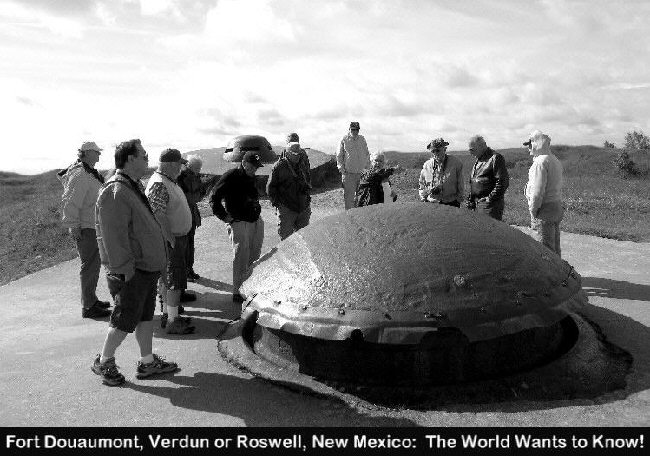
|
|
Page Two
|
C.W.O. Julio "Jay" Ereneta, U.S.N., one of California's last surviving veterans of World War I who also served in World War II, has died at the age of 103. Ereneta died April 15 in San Diego of congestive heart failure, his son Frank said. Having enlisted shortly after the Armistice, he was assigned to the vessels given the dangerous task of clearing the 60,000 mines of the North Sea Barrage.
(link)
USS President Lincoln (1917-1918)
|

S.S. President Lincoln, a 18,168 gross-ton passenger liner, was built in 1907 at Belfast, Ireland, for commercial operation by the Hamburg-American Line. A rather distinctive ship, with six masts, a split superstructure and relatively large cargo capacity, she was mainly intended for the westbound immigrant trade. Trapped in American waters when World War I began early in August 1914, she was laid up in New York Harbor until seized when the United States entered the conflict in April 1917. She was subsequently turned over to the Navy for conversion to a transport and was placed in commission in July 1917 as USS President Lincoln (with no registry ID # assigned).
Repairs and outfitting kept her in port for some time before President Lincoln took her first troops across the Atlantic in October 1917. Four more eastbound voyages to France followed during the next six months. In all, she transported about 23,000 American military personnel to the European war zone. On 29 May 1918 President Lincoln left Brest, France, homeward bound on the return leg of her fifth voyage, accompanied by three other troopships. On the morning of the 31st, while about 600 miles into the trip, she was intercepted and torpedoed by the German submarine U-90. USS President Lincoln sank soon afterwards, with the loss of 26 of the more than 700 persons on board.
On the morning of 31 May 1918, the transport USS President Lincoln was steaming about 600 miles from Brest, France, bound for the United States after delivering a load of American military personnel earlier that month. On board were 715 persons, mainly ship's crew but with about 30 Army officers and men, some of whom were sick and two totally paralyzed. She was accompanied by three other Navy transports, Antigone, Rijndam and Susquehanna, steering a zigzag course in line-abreast formation. They had left Brest two days earlier, convoyed by destroyers, but were now proceeding unescorted since the zone of most serious submarine threat had been left behind.
Just before 9 a.m. the German submarine U-90, which had been tracking the convoy for several hours, hit President Lincoln's port side near the bridge with two torpedoes, immediately killing seven men working below decks. Shortly afterwards a third torpedo struck further aft. The ship was now rapidly settling, and her Commanding Officer ordered her abandoned by all but the crews of her four six-inch guns. These remained on board and kept firing until President Lincoln was close to sinking, in the hope that the submarine might surface and present a target. All but those killed by the torpedo explosions had gone into the water by the time she sank at about 9:30, but three officers and sixteen crewmen were unable to get clear and were drowned.

L. Coxswain Birtie Zanetti, One of 26 Who Perished in the Sinking
M. Postwar Wreath Laying Ceremony at Site of Sinking
R. Lt. Edouard Isaacs Captured After the Sinking--Would Receive the Medal of Honor & Serve in Congress
President Lincoln's 689 survivors, including the two paralyzed soldiers, were now adrift in her boats and life rafts. The other three transports, in accordance with standard procedure in such cases, had continued on their way, though a radio message had been transmitted reporting the sinking. About an hour after the initial torpedoing, U-90 emerged and approached the boats and rafts, searching for a senior officer who might provide intelligence. Despite an effort to remain unrecognized, Lieutenant Edouard V.M. Isaacs was discovered and made a prisoner. His heroic conduct during the subsequent five months was later recognized by the award of the Medal of Honor.
Once the submarine had left the vicinity, President Lincoln's boats and rafts were collected and lashed together in order to minimize the chances of further loss of life. During the night the destroyers Warrington and Smith arrived and took everyone on board, a considerable crowd on two ships of such modest size. While en route back to France, they encountered U-90, attacking her with depth charges but causing no damage. The survivors of USS President Lincoln arrived back at Brest on 2 June 1918. Their ship was the largest U.S. Naval vessel to be lost in the First World War.From the U.S. Navy Historical Center
Read Joe Hartwell's Detailed & Well-Illustrated Article on the President Lincoln (link)
|
A Trip-Wire
Major Article |
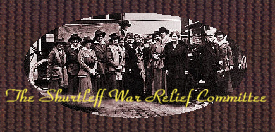 |
| During the Great War affluent and well-educated Americans -- many of them members of the east coast elite -
-gave substantial financial support to and volunteered their services in support of the Entente cause even
before America entered the conflict in April 1917. Thousands volunteered for service in British, Canadian or
French armies. But, these volunteers were not all male and not all were combatants. Among these involved Americans were Helen Cramer Shurtleff, and her husband Congregationalist minister Ernest Warburton Shurtleff, D.D. of Boston. They started a war relief group that came to be known as the Shurtleff Committee. Read Contributor Len Shurtleff's [a distant relative] article about the committee by clicking on the image above. It's in pdf format so you need to download the free Adobe Acrobat Reader if you don't have it. |
|
When War Was Declared - In 1912!
By Christina Holstein
For most people in France, the Great War began on 1 August 1914, the day on which France ordered general mobilisation. However, for the people of the thirteen communes that make up the administrative district of Arraucourt in Eastern France, general mobilisation came earlier - on 26 November 1912.
It was on that night that the chief postmaster at Arraucourt received a telegram ordering him to open one of the secret sealed envelopes that were only to be opened in exceptional circumstances. Instead of opening Envelope No. 2, which ordered partial mobilisation for local army, gendarmerie and customs exercises, the postmaster mistakenly opened Envelope No. 1. This ordered general mobilisation.
He immediately informed the gendarmerie, who posted the information throughout the area. Church bells were rung and town criers with drums called the men to the colours. Workers from the German side of the border were hurriedly sent home and customs men stood guard all night, expecting the Germans to arrive at any moment.
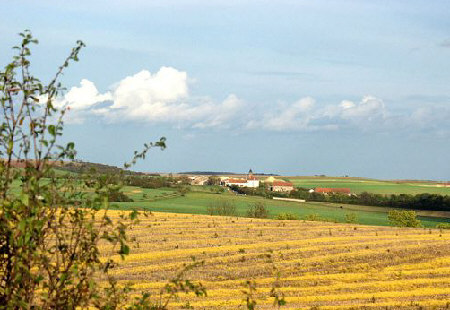
Bathelemont, One of the Villages Affected in the District
The next morning the new recruits arrived at their barracks to find .... that they were not expected. Compensated for their expenses, they returned home to find their families, who were used to war, making stocks of bread, just in case.
This incident took place just after the start of the First Balkan War, at a time when tension was high. To calm matters down, the French Minister for War issued a statement formally denying the order for general mobilisation. The postmaster was brought before a disciplinary council and transferred, the Germans made fun of the event, and the reservists, who had accepted the order 'with calm and devotion' became heroes. Songs were written and patriotic postcards issued showing the reservists marching off to war. In December 1912, the local newspaper, Est Républicain, even launched a public subscription for a bronze statue to be offered to Arraucourt. Named "The Fatherland", this statue, which showed a young Roman warrior, has since disappeared without trace. Perhaps it was destroyed, along with many of the houses in Arraucourt, when the real war came to Eastern France in 1914.
|


Battlefield Scene by Italian-British Artist Fortunio Matania
Click Here to Visit War in a Different Light
|

|
1917 on The Western Front
By Tony Noyes
July 1 - 30
Both Sides Prepare For the
Coming Flanders Offensive
|
The nineteen huge mines at Messines had been blown and the ridge cleared of its German defenders. The mine craters remain, and lost in their own tomb-like silence are the original tunnels! (I recommend a book called Beneath Flanders Fields ISBN 1-86227-237-9 if tunneling is of any interest to you.) The assault had been a resounding success, the troops advancing from one side of the ridge to the other and gaining their first view of the "green fields beyond" stretching to the town of Menin. They could now register their guns on the high ground in rear of the Salient at German-held Gheluvelt.
There was then a six-week wait for those on the ridge allowing them to consolidate their new positions ready for the (yet to be named), Third Ypres or Battle of Passchendaele to commence at 3:50 a.m. on the 31st of July. At that time it was hoped the troops would break out of the strangling German grip of the Salient surrounding the town.
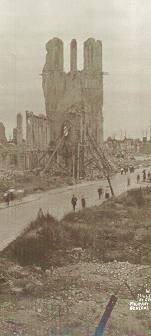
Cloth Hall Ruins |
Ypres ("Wipers" to the British Army) was a ruined town dominated by the ruins of the medieval Cloth Hall. It was so damaged from incessant incoming shelling that it was said a man on horseback could see from one side to the other. The town was itself dominated by a continuous ridge of relatively high ground, giving the German troops a wonderful view over the ruins. The ridge was severely curved over its twelve-mile length, allowing continuous observation from the front, sides and rear by the Germans over the British trenches. This was the Salient.
The water table adjacent to the British trench lines was very high and cut by various small streams with names like the Steenbeek and the Lekkerboterbeek, which had been formed by farmers through the centuries to drain this fertile land. The land is surprisingly undulating in places, and a walk today will produce some quite short steep hills which truncate the skyline. This produces small valleys where a unit can form up without being seen by the opposition and formed the base for many of the subsequent assaults by both sides.
|

German Defensive Bunker, Northern Salient
The main preparatory effort was in the rear of the existing Salient, where access for the advance had to be made by way of roads, light railways, gun positions and ammunition dumps. To the rear, additional infantry camps for the attacking troops had to be set up.
All these efforts had (hopefully) to be hidden from the eyes of the German observers sitting on the ridge above the British trenches, and the German air force was most interested in the antlike efforts below them. Camouflage was difficult since most of the scenery had already been destroyed in the earlier shelling, and the whole battlefield was slowly becoming a single mud colour.
This delay also gave the Germans time to prepare for the coming onslaught; they built some 2,500 (!) concrete pillboxes around the twelve-mile perimeter of the Salient, a few of which remain. They were often built on reverse slopes and thus were invisible to the men on the ground. Often covered in mud-coloured sandbags, they were almost impossible to see in a muddy landscape. Thus the British heavy guns necessary to destroy them could not register accurately and this problem worsened during the fighting.
Barbed wire was placed in great quantities, all positioned to force the attacking troops into fields of fire for the waiting machine guns. The guns could be fired from the pillboxes or often from positions in the open. The wire, of course, was rusty and could not easily be seen at a soldier's eye level and was not clear to the artillery observers trying to destroy it.
Both sides worked industriously for the coming assault, one side being confident of breaking out, and the opposing side confident of containing that assault.
In France, General Petain was slowly winning what we now call the "hearts and minds" of his men. The number of mutinies was declining, and his remedial measures were being implemented across the army. But he remained of the opinion that the army was not yet ready to launch any major attacks on the Western Front for some time to come and he was much inclined to "Wait for the Americans".
July--its first thirty days--became a waiting time.
|
|
If you are travelling to Europe and would like to visit these fields of memory for a detailed tour, please contact experienced guides Tony Noyes or Christina Holstein at Verdun Tours
|
|
|
Subscribe to Our New On-Line Magazine
|
|

|
|
|
Page Three
|
 |
Ernest Hemingway's Humanity
By Joseph Liggera
|
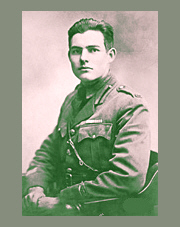
Ernest Hemingway |
At the heart and soul. . .of Hemingway's content is his identification with his audience, which comes from his understanding of their suffering, because of his own. Both are thoroughly modern. Both have been blasted free from the literature that lied about life and into life itself. The Great War created in Hemingway's work a cast of devastated realists that so horrified his parents that they sent back their copies of In Our Time to the publisher and denounced The Sun Also Rises as filth. Hemingway's father, Clarence, wrote him a letter complaining that those people Hemingway wrote about were so disreputable they deserved to go to Hell. His son wrote back with words that still ring with compassion, "I have seen, suffered and been through enough so that I do not wish anyone in Hell."
Hemingway's own creed was clearer than the idealism of his parents' generation. It also lasted longer. Before Catherine dies, Frederic Henry voices what he feels he has experienced as revealed truth:
| |
If people bring so much courage to this world the world has to kill them to break them, so of course it kills them. The world breaks every one and afterward many are strong at the broken places. But those that will not break it kills. It kills the very good and the very gentle and the very brave impartially. If you are none of these you can be sure it will kill you too but there will be no special hurry. |
The mutilated, the crips, the broken, whatever the cause, all come under a new code.
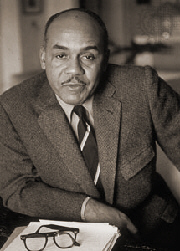
Ralph Ellison |
Hemingway achieved an enlarged humanity that gave values to a number of groups. Ralph Ellison, author of The Invisible Man, wrote in praise of Hemingway's work as meaningful for black people, more so than black writers' fiction itself up to that time, the middle sixties. Ellison commented, "He was a greater writer than the participants in the Negro Renaissance. . .he possessed a truer sense of what the valid areas of perplexity were and a more accurate sense of how to get life into literature." He saw Hemingway's fiction reaching beyond the limits of its specifics in a way that was meaningful to modern people in moderm times:
| |
I believe that Hemingway, in depicting
the attitudes of
. . .expatriates, bullfighters, traumatized soldiers, and impotent idealists, told us quite a lot about. . .Negro Americans. . .who also lived by an extreme code of withdrawal. . .one has only to look upon the world of Hemingway's fiction as offering a valid metaphor. . .for the post World War I period generally. |
From "Hemingway and the Great War" by Joseph Liggera, which recently appeared in the April 2007 issue of
Camaraderie: The Journal of the United States Branch, The Western Front Association.
|
|
World War I Headlines
in the
21st Century
|
|
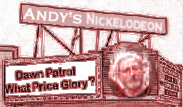 |
Zeppelins in Film
By Andrew Melomet
|
The widescreen cinema was made for Zeppelins. Images of the great silver skyships cruising majestically through azure skies and filling the screen are a lighter-than-air enthusiast's dream. The majority of the great Zeppelin movies are currently available on DVD. However, some of the titles suffer from not being mastered in anamorphic widescreen, and their visual quality is not what it could be.
In 1969 Paramount released The Assassination Bureau, directed by Basil Dearden and starring Oliver Reed, Diana Rigg, Telly Savalas and Curt Jurgens. Based on an unfinished novel by Jack London, The Assassination Bureau takes place in Edwardian England and Europe prior to the Great War. It deals with a secret organization of assassins for hire and concludes with a climactic duel aboard an Imperial German Navy Zeppelin. The juxtaposition of the quaint method of selected assassination practiced by the Bureau and the wholesale slaughter of the coming World War is discussed, and the film features not just an attractive cast but also beautiful sets and an Art Noveau production design. The DVD from Paramount is $14.99 and is 16:9 enhanced for widescreen televisions. While not a great movie, it is still very entertaining, and the authentic-looking external reconstruction of the early model Zeppelin is very interesting. I can't comment on the interior, but it does seem to have everything a Zeppelin needs.
1971 saw two airship movies released, Zeppelin and The Red Tent. Zeppelin was directed by Etienne Perier and stars Michael York, Elke Sommer, Peter Carsten, Marius Goring, Anton Diffring, Andrew Keir and Richard Hurndall as the legendary "Blinker" Hall, Director of Naval Intelligence and founder of the famous radio interception and decryption "Room 40". Michael York is Geoffrey von Richter-Douglas, half Scot and half German, who is recruited by British Intelligence in 1915 to defect to Germany where he is quickly brought into a nefarious scheme to raid a Scottish castle by airship and capture or destroy the Magna Carta. The German High Command feels this will break British war-time morale and help end the war. Elke Sommer is the best-looking aeronautical engineer the screen has ever seen. The plot is far-fetched to say the least, but this is still a fun adventure film, and after watching it several times I'm convinced I know how to fly a Zeppelin. It features a superb recreation of a Zeppelin interior, and the exterior shots of the German airship sheds were actually filmed at the surviving British airship sheds constructed for the R100 and ill-fated R101. The scenes of the Scottish castle attack by German soldiers were filmed in Malta. The lovely cream-colored Malta is a giveaway for anyone who's been there. Unfortunately, Zeppelin was released on DVD in only in Australia and is currently out of print.
The Red Tent was an Italian-Russian co-production on the expedition of the N4 semi-rigid airship Italia to the North Pole. Peter Finch is Umberto Nobile, the famous Italian aeronautical engineer and arctic explorer. Sean Connery is the Norwegian explorer Roald Amundsen. Nobile's expedition ended in disaster and The Red Tent covers not only the details of the tragic expedition (Roald Amundsen lost his life in the search effort) but also the decades of guilt felt by Nobile by being rescued and evacuated before more seriously injured crew members. The Red Tent is $14.99 from Paramount and is enhanced for 16:9 televisions.
The Hindenburg was released in 1975. Directed by Robert Wise, it features a cast headed by George C. Scott, Anne Bancroft, William Atherton and Roy Thinnes. Albert Whitlock, the noted matte artist gets credit for the special visual effects of bringing the Hindenburg to life on the screen. This film effectively captures the visual grandeur of the great airship from a searchlight-lit nightime launch to its inevitable end. There are beautiful scenes of the Hindenburg flying over icebergs and the 1937 skyline of lower Manhattan. Inside the airship, the surround sound kicks in with all the structural groaning of girders and mechanical sounds of the flight. Contemporary-critics faulted Robert Wise's low key approach to the drama aboard the airship as Scott's character looks for a saboteur and time bomb, but in retrospect his subdued depiction of the disaster is far more appealing than the anything-goes style of Pearl Harbor. It's a pity this title is not available in an anamorphic edition and has not been restored and remastered. The DVD is $14.99 from Universal.
In 1989 Indiana Jones and the Last Crusade, directed by Steven Spielberg and starring Harrison Ford and Sean Connery featured a daring escape from the fictitious LZ-138 by the Joneses. They make their way into a plane carried by the Zeppelin (similar to those carried by the USS Akron and USS Macon, the U.S. Navy airships) and drop away to eventually land. Actually, the German airship service never used parasite aircraft or developed the flying aircraft-carrier concept. The scenes of the airship launch were filmed at Treasure Island in San Francisco Bay. The surviving Art Deco buildings from the 1939 Golden Gate International Exposition became the structures at the German airfield. Astute Indiana Jones fans also know that the Short Solent Flying Boat used in Raiders of the Lost Ark is also in the Bay Area. It's part of the collection of the Oakland Aviation Museum (formerly the Western Aerospace Museum). Indiana Jones and the Last Crusade is available separately or as part of The Adventures of Indiana Jones collection from Paramount. It's widescreen enhanced and packed with special features.
In 1991 Walt Disney Pictures released The Rocketeer, based on Dave Stevens's comic book character. Taking place in a recreated 1938 Los Angeles, it includes a fiery climactic battle aboard a Nazi Zeppelin over the Hollywood Hills. Unfortunately, the $14.99 DVD is non-anamorphic and does little justice to the lovingly detailed production design, special effects and beautiful period airplanes. Fans of the Rocket Man Republic Pictures serials will immediately recognize the homage to the original character.
2004's Sky Captain and the World of Tomorrow was written and directed by Kerry Conran. Set in an alternative 1939 when the civilized world is under attack from giant flying robots, it was one of the first movies to be shot with the cast on a virtual back lot in front of a green screen. Sky Captain opens with a highly atmospheric docking of the fictitious Zeppelin Hindenburg III at the mooring mast on the Empire State Building during a snowstorm. Of course, although a mooring mast was part of the Empire State Building's design, no passenger airship ever docked there. This Paramount title is only $9.98 on DVD or $29.99 on HD DVD or Blu-Ray DVD.
Zeppelin! was a 2005 German release directed by Gordian Maugg. The story follows the grandson of a Hindenburg airship crewman investigating his grandfather's life and 1937 death at Lakehurst. Unfortunately, this title is not available on DVD in the United States or Europe.
The most recent movie to feature a Zeppelin is Flyboys, from 2006. Loosely based on the Lafayette Escadrille, Flyboys includes a major air battle during a daylight Zeppelin raid. The $29.99 DVD from MGM is well-produced and is also available as a $39.99 Blu-Ray DVD. My October 2006 review of the theatrical release of Flyboys can be accessed from the archives.
Perhaps the most interesting of all the widescreen Zeppelin movies is one that never made it out of pre-production. Hammer Films' Zeppelin v. Pterodactyls would have told the story of Allied prisoners escaping from a German POW camp in a stolen Zeppelin. Eventually the airship drifts into a lost world where it is attacked by a pterodactyl. After crash landing the crew encounters prehistoric creatures and humans. Only the evocative poster survives from this mind-boggling concept.
Andrew Melomet, Proprietor of Andy's Nickelodeon, will answer your Great War film or video inquiry. He is also soliciting your recommendations for the WWI Filmography he is compiling for our readers. Just click HERE.
|
|
| The following are thanked for their contributions to this issue of the Trip-Wire: Donna Cunningham, Terry McGill, Joe Liggera, Tony Langley, Christina Holstein, Tony Noyes, Andy Melomet, Kimball Worcester, and Len Shurtleff; Steve Miller, the members of the 2007 WFA battlefield tour, our Western Front photographer; and the U.S. Navy Historical Center. Until next month, your editor, Mike Hanlon. |
SUBSCRIBE TO THE TRIP-WIRE
(Or send it to a friend)
(Or send us a comment on the TRIP-WIRE)
CLICK HERE TO CONTACT US VIA EMAIL |
For further information on the events of 1914-1918
and membership information visit the Directory Pages of:
|
| |

























